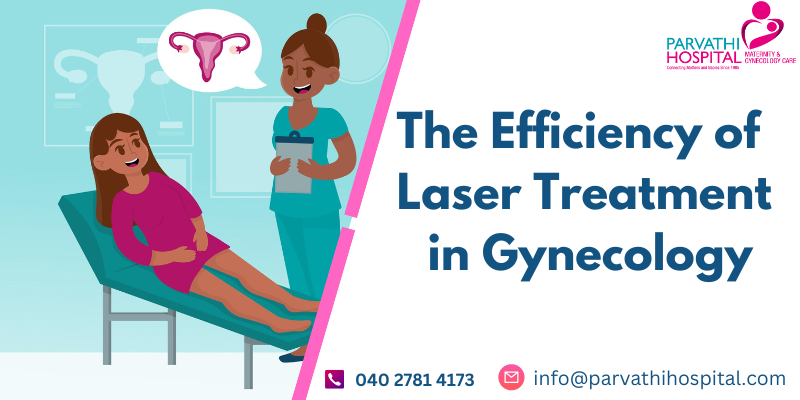The Efficiency of Laser Treatment in Gynecology

Technological innovations are actively implemented in a person’s daily life and different areas of professional activity. Modern technologies now give doctors many options for treating diseases and diagnosing them. For example, laser technology has recently gained popularity and application in gynecology. A plethora of laser equipment, both invasive and non-invasive, has emerged and is successfully used by gynecology specialists. Laser treatments in gynecology help to cure symptoms of the female genital organs. Pathologies of both external and internal organs can be treated with a laser.
Laser technologies, commonly used in surgeries and other medical specialties, have found use in gynecological practice. Lasers in gynecology have been used since the 1960s. It is considered the gold standard for minimally invasive gynecology. In the case of gynecology issues, laser beams are used to decimate microscopic lesions with high precision in the female genital tract.
What Is Laser Therapy?
Laser therapy is a therapeutic effect on body tissues that is performed by using directional light rays that correlate to a specific spectrum. Its application enables the following outcomes:
- Enhances the body’s defenses
- Activates the internal regulation processes
- Improves blood circulation in the affected area
- Removes Inflammation
- Mobilizes body biological resources
- Accelerates recovery processes
Benefits Of Using Laser In Gynecology
Gynecology studies the physiology and pathophysiology of the female reproductive system. The advancement of laser technology in medicine has advanced rapidly in recent years, and these devices are now available. Currently, it is widely used in surgical treatment. Lasers have become commonly used in gynecology treatments as well. The essence of the laser effect on the body’s tissues is the evaporation of living tissue cells.
The primary advantage of using a laser in obstetrics and gynecology is its selective effect on body tissues. The laser beam only affects pathological tissues while leaving healthy tissues alone. Furthermore, the beam can be removed even from the minor pathological areas because the beam is thin. Other advantages of laser therapy are as follows:
- Laser is painless and atraumatic,
- There is no need for the patient to be hospitalized, and the rehabilitation period is brief.
- Cicatricial deformities do not occur after the laser beam and can be used to treat cervical diseases.
- It is possible to perform intimate plastic surgery with high quality and speed using a laser beam.
Pathological Conditions Treated by Lasers in Gynecology
The impact of a focused, thin light beam with high power produces this effect. In addition, the laser also has analgesic, anti-inflammatory, regenerative, and desensitizing impacts, allowing it to treat many gynecological pathologies effectively. Here are some pathological conditions that the laser commonly treats in gynecology.
- Cervical erosion and dysplastic processes
- Endometriosis in different locations
- Cervical cicatricial changes
- Cervical inflammation that lasts a long time
- Several retention cysts
- Incontinence of the bladder
- Vaginal ailment
- Atrophy of the vaginal mucous membrane.
3 Types of Lasers Used in Gynecology
Laser surgery in gynecology has numerous advantages compared to an electric current or a scalpel. As a result, these technologies are actively implemented in all areas of medicine. Here are some examples of lasers used in gynecological treatments.
Carbon dioxide (CO2) Laser
CO2 laser technology’s versatility in providing four energy delivery modes and a wide range of dedicated applicators makes it the most comprehensive and effective treatment platform for feminine health. The CO2 laser is used in areas where cautery would be dangerous, such as the bladder, lateral side wall near the ureter, and bowel serosa. In addition, by increasing the power density, the CO2 laser can be used for excision or incision in addition to vaporization.
The FDA has approved CO2 surgical laser systems for use in gynecological laser surgery procedures for soft tissue incision and the treatment of:
- Conization of the cervix
- Condyloma
- Leukoplakia (vulvar dystrophies)
- Herpes vaporization
- Urethral caruncle vaporization
- Cervical dysplasia
- Benign and malignant tumors
- Hemangiomas
- Benign and malignant lesions of external genitalia
- Condyloma
- Phimosis
Erbium Laser
More up-to-date and accurate. It has almost no effect on the surrounding tissues. Very short pulses characterize the action of an erbium laser. The water in the cells absorbs energy and begins to evaporate in this case. However, the impact stops at this point, and the liquid fraction returns. Cells are destroyed as a result of such fluctuations.
The erbium laser is the most optimal and safe for surgical interventions in gynecology practice.
Photon Laser
A special erbium laser, including plastic, is widely used in gynecology operations. They are performed on the Fotona device, so the technology bears the same name.
The essence of the method is the use of a laser to process tissues, anterior wall, aperture of the vagina, circular processing of the entire mucosa. They begin to produce more collagen fibers as a result, and they become more elastic. As a result, the vaginal structure is updated, narrows slightly, and toned pelvic floor muscles. All of this improves the quality of a woman’s sexual life and eliminates many problems at various ages.
Photon lasers are increasingly used in plastic surgery. They are required in the following circumstances:
- Recovery of postpartum vaginal tone and volume
- Rejuvenation of vagina
- Treat some forms of frigidity by stimulating the “G” point and enhancing natural sensations during sexual intercourse.
- Removes stress urinary incontinence to correct the initial stages of omission of the vaginal and uterine walls.
- Atrophic colpitis in menopausal women.
The use of a laser implies the direct effect of radiation on blood flow via a special conductor placed in a venous vessel. It has anesthetic, immunostimulant, and anti-inflammatory effects, accelerates metabolism, self-regulation, and many other beneficial effects on the body. It falls under the umbrella of physiotherapy.
How does laser help in fertility and gynecology?
Different types of lasers help a woman and a man conceive depending on the cause of infertility. When it is necessary to remove tissue, or a neoplasm, erbium and carbon dioxide are used. For instance, it treats septum in the uterus or vagina, endometrial foci, polyps, and uterine diseases. Endoscopic surgery and drug treatment can combine with laser treatment.
In addition, it helps when a chronic infection is the cause of the inability to become pregnant or carry a child. This method can also improve men’s sperm quality by increasing mobility and the number of normal forms.
- Laser therapy is used in gynecology in the following situations:
- Chronic inflammatory processes in the pelvic region, such as the uterus and appendages.
- Women with recurrent HSV types 1 and 2, especially during pregnancy preparation and after 32 weeks before delivery.
- To avoid exacerbations during pregnancy in chronic pyelonephritis, with varying degrees of endometriosis,
- To reduce infectious complications before surgical interventions.
Preparation For Laser Treatment
The technique and method of pathology must be considered when preparing for laser treatment. Most of the time, the following is required:
- Blood and urine analysis in general, as well as biochemical research
- If the operation is extensive, the definition of the group and the Rh factor, as well as HIV and hepatitis markers, will be performed.
- In the event of an intervention on the external or internal genitals for a vaginal smear and cervix
- To perform a colposcopy after the removal of cervical or vaginal tissue.
It is impossible to predict how long, and how many treatment stages will take. The sequence and methodology depend upon the doctor’s intention to burn the abnormal areas and remove tissues.
Treatment with erbium and carbon dioxide lasers typically entails the excision of specific areas such as the cervix, condyloma, and septum. In some circumstances, the procedure can be performed under local anesthesia; in others, intravenous anesthesia is required, which is deeper for voluminous operations.
Photon laser treatments are done using a unique installation placed in the vagina, which treats the tissue according to the specified parameters.
Recovery after laser treatment
Recovery time following laser treatment is much shorter than for similar techniques using other types of energy. However, the recovery and rehabilitation length depend on how many tissues are removed and concomitant diseases.
Final Words
Laser therapy has many advantages over other methods of treating gynecological diseases. It is virtually harmless to women, but a specialist with preliminary study results should always determine its ability and order of use.









